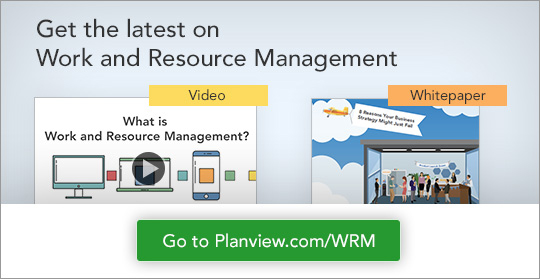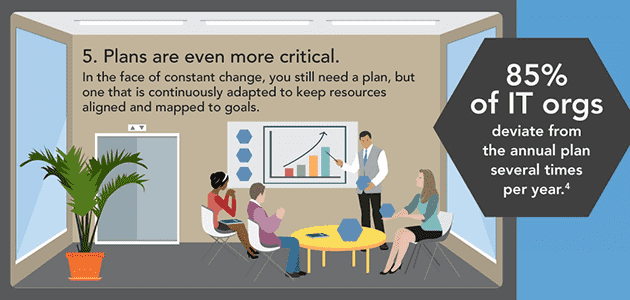
Eight forces are increasingly bearing down on businesses as they try to adapt to customer demands and innovate. If not harnessed effectively, these forces can create a snowball effect. In particular, the last two forces that I covered in my countdown – work methods are proliferating and unstructured work is exploding – can cause even more chaos if not focused appropriately.
This is why “plans are even more critical” – force number five. In the face of constant change, you still need a plan, but one that is continuously adapted to support changing conditions and strategies.
- Outcomes are different
- Capabilities must be strategic
- Work methodologies are proliferating
- Unstructured work is exploding
- PLANS ARE EVEN MORE CRITICAL
- Teams are virtual and global
- Technology is everywhere
- Resources are multiplying
Here’s how I described the criticality of planning to our customers last fall.
Plans Are Even More Critical
As organizations move faster and employ more types of work, processes, tools, and resources to get things done, strategic planning becomes more imperative. While work is a constant in every organization – employees always seem busy – the question is whether or not their output is on strategy.
This becomes more difficult as companies alter their strategies and try to change course on the fly. In the absence of clear directives and plans that tie directly to their day-to-day work, employees may be unwittingly doing tasks that do not support – or worse, work against – the company’s objectives.
For this reason, leaders must constantly connect strategy to execution across their organizations. This requires planning, but annual planning no longer suffices in an era where agility is required to survive and thrive. And let’s be clear, when I refer to agility I mean “business agility” not capital “A” as in Agile work methods.
In its December 2016 report “Eight Steps For Building Strategic Portfolio Management,” Forrester wrote:
“Static business strategy, annual planning cycles, and disconnected execution activities fall short when the business and competitive landscape is continually changing…Traditional waterfall planning and portfolio management practices can’t keep pace with the change required to compete in an increasingly digital world, because they:
- Assume a broadly understood vision and single strategy to achieve it…
- Can’t assess and quickly adjust to market change…
- Lack insight to seize new opportunities…
- Lack timely feedback needed to course-correct.”
This lack of agility has dire consequences. A Project Management Institute study found that organizations without agility are less likely to complete projects and strategic initiatives successfully. As a result, organizations lose $109 million for every $1 billion they invest in projects and programs.
On the other hand, organizations that are “highly agile, nimble and able to respond quickly to changing market dynamics complete more of their strategic initiatives successfully than slower, less agile organizations (69 percent versus 45 percent).” However, only nine percent of organizations reported themselves as “excellent on successfully executing initiatives to deliver strategic results.”
How can organizations achieve this agility while staying focused on what matters? Part of the answer lies in continuous planning. This is where Planview’s evolution to Work and Resource Management comes into play. Our products facilitate the continuous planning that organizations need to adapt to constantly changing markets and customer demands.
Our resident planning guru Carina Hatfield has built out an entire web site devoted to the subject of continuous planning. It has a wealth of literature and videos about how organizations can – in Carina’s words – “Create a dynamic continuous planning process that improves your ability to prioritize and adapt, ensuring you are delivering value to the business while considering capacity constraints.”
For more information on the eight forces working against your business, visit https://www.planview.com/work-resource-management/.
I’d like to hear from you. How does your organization typically plan and execute on products, services, and applications? Share by leaving a comment below.






